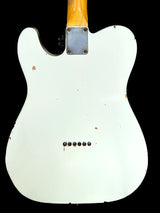Author: Leoni Moreno
Whenever it’s time to acquire your new guitar, we always consider getting a famous brand that will assure we have a quality product in our hands. But what most people tend to forget is the whole world of boutique brands, that have changed the way a lot of artists look at the market and their instruments. Owning a bespoke product is a great way of taking the next step with your collection, and having the certainty that you possess an item that was not made in batches, but instead, carefully designed and forged within your specifications and taste. So, let’s talk about those brands and how this niche affects the market.
The word Boutique etymologically comes from the homonymous French word and has its roots attached to Hellenistic Greek. Its translation literally means “Store” or, as for the Greeks, “Storehouse”. Nowadays, the term is used to refer to a brand or facility that produces a small range of manufactured products that are not stocked nor sent out, but meticulously studied, designed, and crafted whenever there is a demand.

For the guitar world, some pioneer brands started as small stores that began delivering high-end instruments at the end, like Suhr, PRS, and James Trussart. All those brands have more than 40 years of history and therefore have been reframing the market with guitars and later gears, with a manufactured artwork that excluded the precedence of the huge brands of a “soulless” product.
The main reason for it is because the overall development process of a hand-crafted guitar is an artisanal work. Each stage is carefully taken care of to assure their roles in composing a bigger image. It’s a wrongful statement to affirm that a craft guitar will have an inferior quality in comparison to an industrialized instrument, even from smaller brands. The artwork made by these boutiques is not only visually appealing but also designed on behalf of quality over quantity. We are able to spot this in the quality of the materials, for example, which are handpicked, examined, and developed differently for each individual project.
This not only adds a whole other value to the product, but guarantees that their knowledge, experience, and precision are printed through their whole process, and can be reproduced among their series. From pedals, amplifiers, picks, and the whole stack of materials that are placed at your instrument. That also assures that not only the most expensive or the one with the most components have the most investment and attention, but even their starter crafts and budget-friendly equipment will be as beneficial as the other ones.
Being able to develop a ranged market for all those fond of expanding their collection (or to begin it) is another great way to add value and mainly sophistication to your artwork. The idea of only buying a guitar, picking the color and the style that gets you comfortable is renewed. When you choose a boutique brand, you are not only picking an assembled instrument that is produced by thousands.

You are requesting a new creation, something that will be unique and will sprout a new life from it. With that in mind, we can understand that all those details, lines, screws, frets, switches, and other pieces are meticulously selected, planned, and developed to match the final piece. The care through the process is what makes the design look like it’s alive. The majority of the craft is not done by machinery, but by a set of artisans, who make sure to print their quality on every process.
That is another reason that makes every creation unique. Not only the customization allows you to have an instrument that matches your needs as an artist, but mainly because the order you made was unique. The chances of having another piece like yours are extremely low for two reasons.
As previously stated, you are not getting a stock product that has been cataloged according to its shape, material, or color. The crafting process is focused on developing only when the order comes out, so that’s the first reason why this is so special. The second one would be the chances of having the exact same model as someone else, as the possibilities of customization could go over eight million options from the overall material to the color of the fret or the shape of your pickups. That’s what we talk about whenever bringing exclusivity as a topic.
But one thing that we usually wonder more about whenever we are buying our newest guitar is the safety and the support that we are expecting if anything goes wrong. Are we able to receive some help with the process? Is there a local dealer nearby that can assist me? How do I get in touch with the dealers or the manufacturer to have my warranty endorsed?
No doubt that this would be one of the many concerns involving the acquiring of a new instrument, but the vast majority of boutiques have as their terms to assist their consumers worldwide. Most of them have a return policy within 10 days of the delivery to make sure that there is no flaw or major failure due to the craft itself. After that, the artist may have up to one or two years of warranty, which shall aid in cases of degradation through time or crafting issues. The guarantee does not cover any improper use or handling of their products, so make sure to be careful with the usage.
Also, if you have any doubts about your equipment features, possible adjustments, or want deeper info about your gear, the brands' websites often provide a variety of manuals, instructions, and even some tips to better keep and use your new instrument. Those platforms also provide a list of dealers (most of them in the US) and a direct contact means, which allows you even to put in your guitar’s serial number so you can be aided accordingly to your problem, as your order and guitar's serial number are registered.
The boutique’s artworks are something that renews the vision of owning an instrument. It is still a vast market that should be taken more into consideration whenever expanding your collection, as the quality printed, and the value of this market tend to increase through time. Possessing a piece that will withhold authenticity is a great way to take your vision and music to a new level and to ensure that the melody played is sustained by not just an instrument, but by the whole artwork itself.



